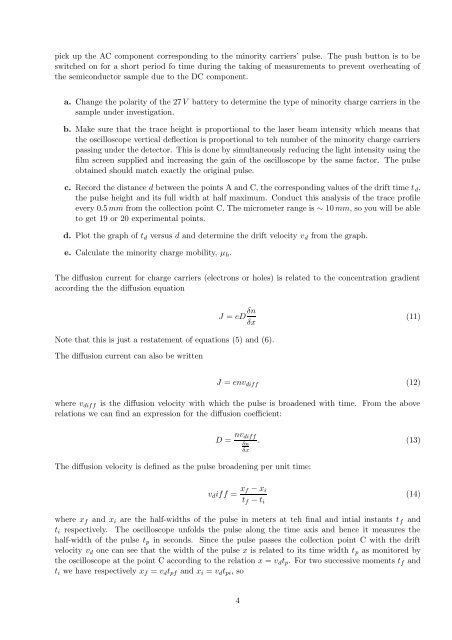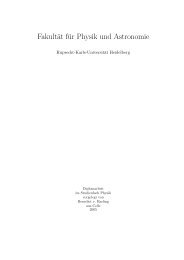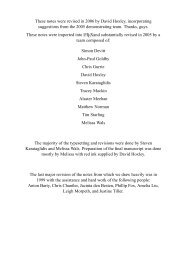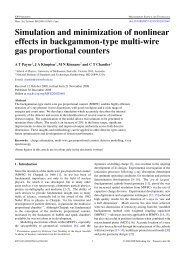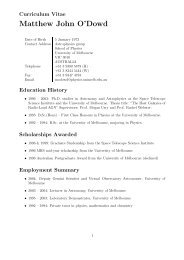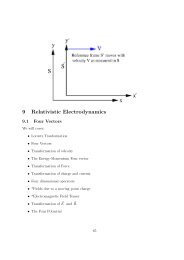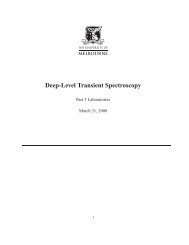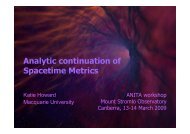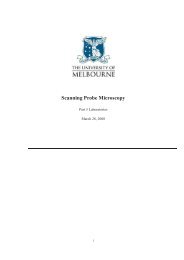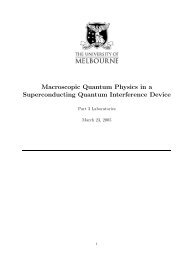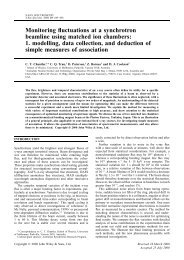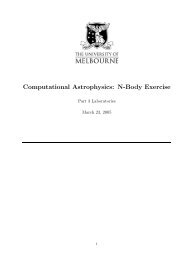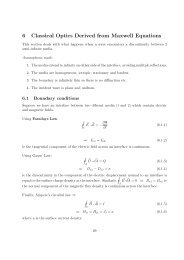1 Introduction 2 The Haynes-Shockley Experiment
1 Introduction 2 The Haynes-Shockley Experiment
1 Introduction 2 The Haynes-Shockley Experiment
You also want an ePaper? Increase the reach of your titles
YUMPU automatically turns print PDFs into web optimized ePapers that Google loves.
pick up the AC component corresponding to the minority carriers’ pulse. <strong>The</strong> push button is to be<br />
switched on for a short period fo time during the taking of measurements to prevent overheating of<br />
the semiconductor sample due to the DC component.<br />
a. Change the polarity of the 27 V battery to determine the type of minority charge carriers in the<br />
sample under investigation.<br />
b. Make sure that the trace height is proportional to the laser beam intensity which means that<br />
the oscilloscope vertical deflection is proportional to teh number of the minority charge carriers<br />
passing under the detector. This is done by simultaneously reducing the light intensity using the<br />
film screen supplied and increasing the gain of the oscilloscope by the same factor. <strong>The</strong> pulse<br />
obtained should match exactly the original pulse.<br />
c. Record the distance d between the points A and C, the corresponding values of the drift time t d ,<br />
the pulse height and its full width at half maximum. Conduct this analysis of the trace profile<br />
every 0.5 mm from the collection point C. <strong>The</strong> micrometer range is ∼ 10 mm, so you will be able<br />
to get 19 or 20 experimental points.<br />
d. Plot the graph of t d versus d and determine the drift velocity v d from the graph.<br />
e. Calculate the minority charge mobility, µ h .<br />
<strong>The</strong> diffusion current for charge carriers (electrons or holes) is related to the concentration gradient<br />
according the the diffusion equation<br />
J = eD δn<br />
δx<br />
(11)<br />
Note that this is just a restatement of equations (5) and (6).<br />
<strong>The</strong> diffusion current can also be written<br />
J = env diff (12)<br />
where v diff is the diffusion velocity with which the pulse is broadened with time. From the above<br />
relations we can find an expression for the diffusion coefficient:<br />
D = nv diff<br />
δn<br />
δx<br />
<strong>The</strong> diffusion velocity is defined as the pulse broadening per unit time:<br />
. (13)<br />
v d iff = x f − x i<br />
t f − t i<br />
(14)<br />
where x f and x i are the half-widths of the pulse in meters at teh final and intial instants t f and<br />
t i respectively. <strong>The</strong> oscilloscope unfolds the pulse along the time axis and hence it measures the<br />
half-width of the pulse t p in seconds. Since the pulse passes the collection point C with the drift<br />
velocity v d one can see that the width of the pulse x is related to its time width t p as monitored by<br />
the oscilloscope at the point C according to the relation x = v d t p . For two successive moments t f and<br />
t i we have respectively x f = v d t pf and x i = v d t pi , so<br />
4


